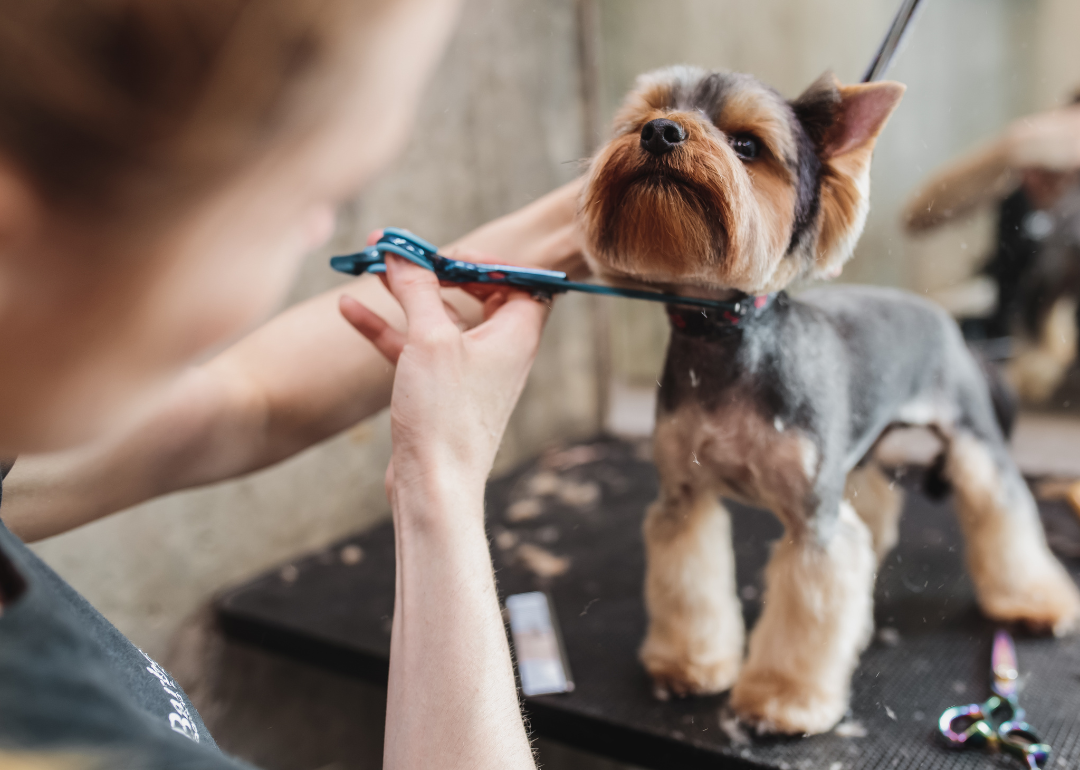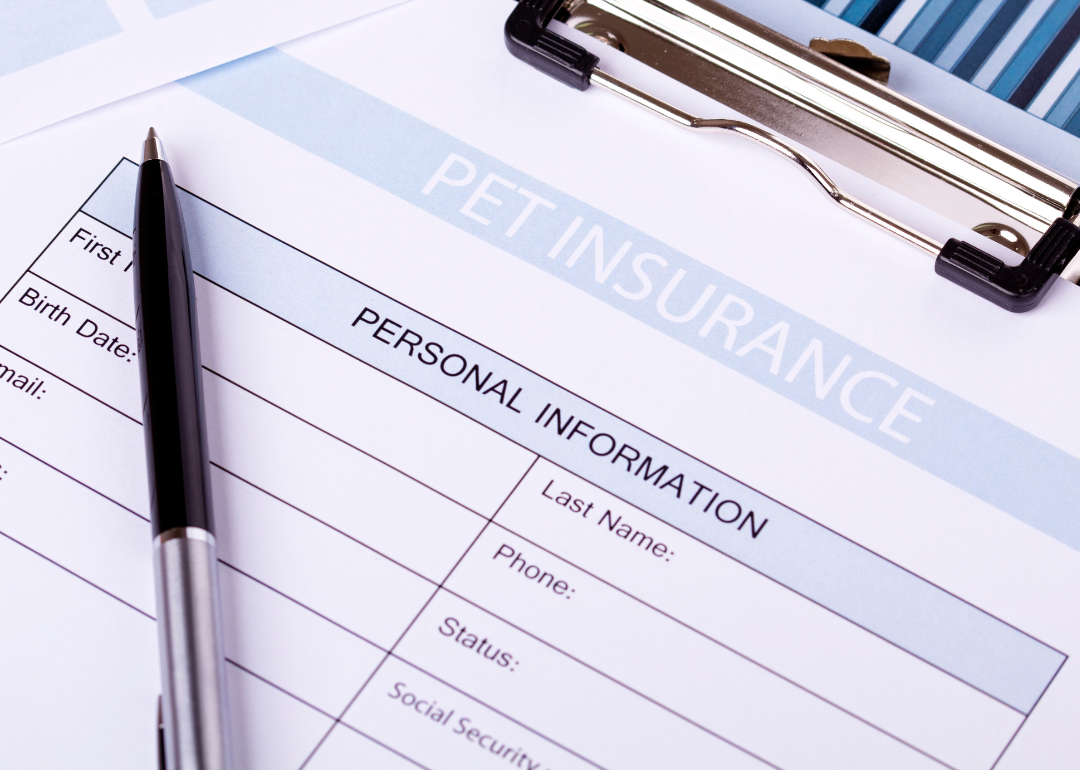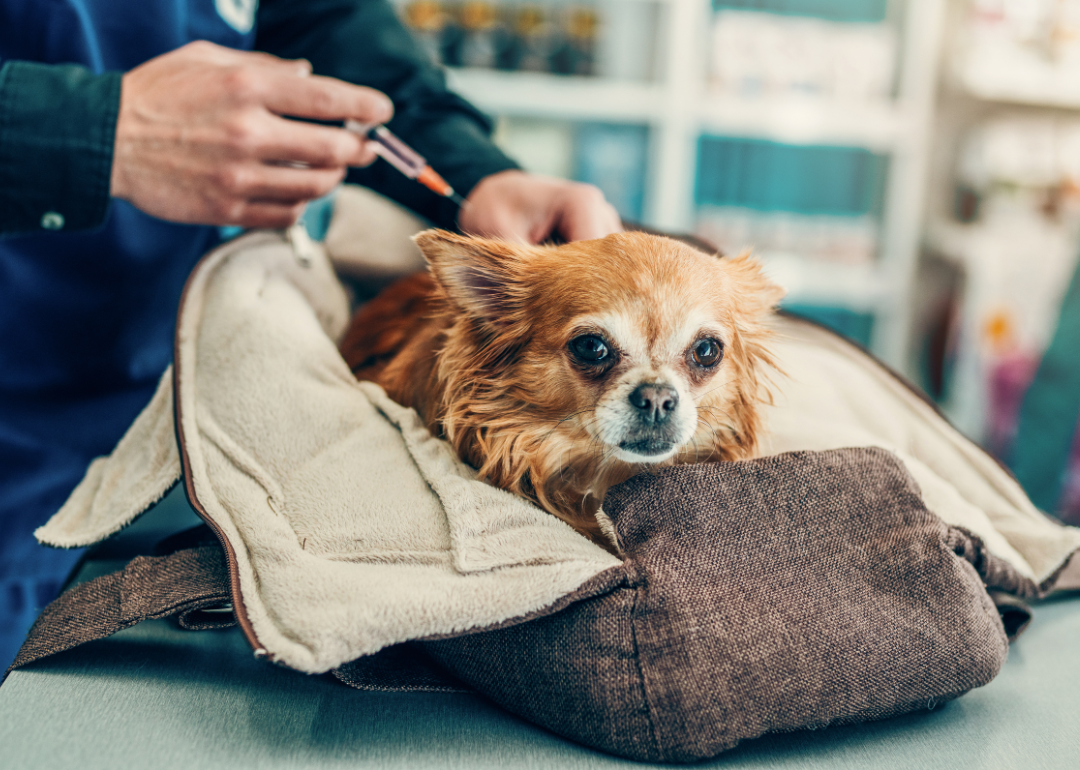9 ways to save on dog care

Rovsky // Shutterstock
9 ways to save on dog care
A dog groomer trims the coat of a Yorkshire terrier in a grooming salon.
Few things in life offer the comfort and unconditional love that comes with dog companionship.
Due to an increase in remote work and time spent at home after the onset of the COVID-19 pandemic, it’s no wonder that households with dogs rose by 11% . In the U.S., an estimated 48 million households—nearly 40%—have a dog.
Dogs can bring their human companions great emotional support and joy, but they can also be high-maintenance animals that come with costs for care. Pet care bills can accumulate quickly, between vet bills and vaccinations, grooming, food, dog walkers, and pet sitters. People spend, at minimum, an estimated $15,000 on a dog in its lifetime. With inflation pushing everyday costs to record highs, many households are looking for ways to cut their expenses for their furry family members.
Wag! compiled a list of 10 ways to save money on dog care using news and information from veterinarians and pet care experts. These small changes can still prioritize dogs’ health and well-being while cutting unnecessary costs. Keep reading for tips that could save hundreds or even thousands of dollars annually on pet care.
![]()

Canva
Ignore ‘made for dogs’ products
A dog having its teeth brushed by its owner
Many people buy products specially marketed toward specific animals—but many generic items are just as good and available at a fraction of the price.
While brushing your dog’s teeth can be crucial to maintaining oral health, you don’t necessarily need a fancy, dog-branded toothbrush: A soft-bristled toothbrush for humans will garner the same results.
Another excellent substitution is human tennis balls, which are much cheaper at a sports equipment shop than at a pet store. Despite concern over damage to dogs’ teeth when using human tennis balls, blunting (wear on canine teeth from tennis ball fuzz) rarely causes any long-term issues in dogs. It may also be safer for your pet’s health, as dog toys often contain unregulated toxic chemicals, unlike human tennis balls.
Be sure to do your research before substituting items for your pets, as your favorite shampoos and lotions may have chemicals harmful to their skin or fur. Always be sure to diligently check the quality of any products before playtime.

Canva
Think twice before buying expensive organic brands
A dog eating food from a bowl
Finding the best food for your dog’s well-being is essential for their health, but organic doesn’t necessarily mean better. Researching the differences and effects of organic versus basic kibble could glean insights if you’re looking to cut costs on your pet care.
The four most essential elements in dog food are protein, fat, fiber, and water. Familiarizing yourself with how to read a dog food label is a great way to ensure you’re making the right nutritional choices for your dog to support its lifetime health. There are many brands that offer quality food without the fancy brand name—or high price tag. Home cooks can also consider making homemade dog food using quality ingredients bought in bulk that they can prepare in large batches at home, often for less than at the store.

Canva
Consider pet insurance
A pet insurance application
While the cost of pet insurance may seem daunting as an ongoing expense, choosing the right insurance will save you money in the long run.
If you’ve ever taken a dog to the vet, you know the stress of emergency vet visits and procedures all too well—along with the hefty bill that follows. These costs can be avoided (or at least mitigated) with a pet insurance plan. By the end of 2021, more than 4 million North American pets were insured, according to the North American Pet Health Insurance Association. The average annual insurance premium covering accidents and illnesses for a dog was $583.91.
Certain factors will affect the cost of your dog’s pet insurance, such as age, zip code, and breed. For young dogs, you may want to take advantage of smaller premiums. Averages show that people spend $700-$1,500 annually on vet visits for routine care, not including emergency bills or medications.
Pet insurance is usually split into three categories: comprehensive, emergency or accident only, and accident and illness. Be sure to choose the right one for your pet’s lifestyle, as pet insurance could save you thousands annually. While pet insurance premiums range from $10 to $100 monthly, people, on average, pay $30-$50 a month, which is still lower than most annual veterinary bills.

jsimkins // Shutterstock
Make your own dog toys
A Golden Retriever with a tennis ball in its mouth
Pet stores often hike the prices of their dog toys to secure a profit, although most have inexpensive materials such as rope, fabric, cotton, and plastic. Making dog toys is relatively simple and can be made with items around the house, such as old T-shirts, socks, and tennis balls.
Rather than break the bank with a toy your dog will tear to shreds in days, crafting high-quality and durable toys at home is ideal—and cost-effective—for dogs that cycle through them quickly.

Becky Swora // Shutterstock
Make your own dog treats
A tray of homemade dog treats
Whether training your dog or simply indulging them, treats are a must-have around the house.
The cost of treats can be expensive, however, especially for new puppies who will need a steady supply as they train with a consistent reward system. You can use everyday household grocery staples to make dog treats and often include dog favorites such as peanut butter, chicken, or sweet potato. You can use rice, flour, and broth as a base for many of your treats, and recipes will often yield more goodies than a plastic bag from a pet store.
Dog treats can be baked, frozen, or simply mixed and cut into pieces. You should also take advantage of your local butcher shop, as they usually have cheap cuts of meat or bone marrow which can be the perfect snack for your pup.

Canva
Groom your dog at home
A dog being brushed at home
The grooming regimen for your dog will vary based on breed and temperament, but standard practices include nail trimming, brushing, bathing, ear cleaning, and tooth brushing. Unfortunately, the luxury of dropping your dog off at a groomer can quickly add hefty costs to monthly expenses.
Learning basic grooming techniques can help to spread out trips to the groomer or may allow you to forego that service entirely. Taking on some grooming duties will also afford essential bonding with your animal while giving you important insights into your dog’s health, from spotting ticks or fleas to discovering rashes or tumors.
Be sure to obtain the correct tools and research care for your dog’s breed before grooming your pet at home. You can even ask your veterinarian or groomer which tools they recommend for home use.

Canva
Stay up to date on vaccines
A small dog getting a vaccine
Vaccines offer safe and effective immunizations against diseases like rabies and hepatitis. An advantage of rescuing dogs from shelters and humane societies is that dogs often have already got their standard vaccines, and the adoption fee will cover that. For puppies who come from breeders or other situations, it’s essential to administer vaccines quickly so they can safely explore the outdoors and socialize with other animals.
The average household spends $75-$150 on annual vaccines, with prices varying based on the dog’s lifestyle. Keeping up with yearly vaccinations will avoid costly trips to the vet for preventable diseases. Depending on availability, humane societies and shelters often offer discounted or free vaccinations for pets, so check all your local resources.

Canva
Dental care can be more affordable at specialists than the regular vet
A person opening a dog’s mouth as they hold a toothbrush.
While visiting the vet is essential for any medical issues your dog may face, you may save a significant amount by visiting a dental specialist rather than a vet for any dental care your pet may need.
Maintaining your dog’s dental hygiene is a cost-effective precaution for preventing oral infections and diseases. Ideally, you can take keep up healthy dental hygiene habits by brushing your dog’s teeth at least once a day—or at least once a week—with the proper toothpaste recommended by a veterinarian.
Brushing your dog’s teeth at home may not be feasible due to your schedule or your dog’s temperament. Going to a dental specialist can help avoid hefty tooth cleaning fees at the vet, which average around $300-$700. This care may also prevent painful gum diseases and infections, where treatment or tooth extraction can cost as much as $3,000. Periodontal disease affects an estimated two-thirds of dogs older than 3, caused by a buildup of plaque and the start of gingivitis. It can lead to painful tooth loss if left untreated.
While dental specialist prices vary, tooth cleanings and extractions will be far cheaper than visiting a vet’s office.

Canva
Sign up for pet store loyalty programs
A Dalmatian in a pet store picking a new bowl
If you tend to purchase many of your dog’s items from the same stores, it could be time to start a loyalty program. Not only will you have access to exclusive deals, but you can steadily build up points for future purchases. Most loyalty programs are free and many offer sign-on bonuses. It may be wise to search for loyalty programs around the holidays, as these are peak times for sales and sign-on benefits.
Consider taking advantage of department discount stores, which offer excellent promotional or sign-on deals while offering items marked down by up to 60% or more. Most of these stores have pet sections with items like beds, leashes, collars, and toys.
This story originally appeared on Wag! and was produced and
distributed in partnership with Stacker Studio.
